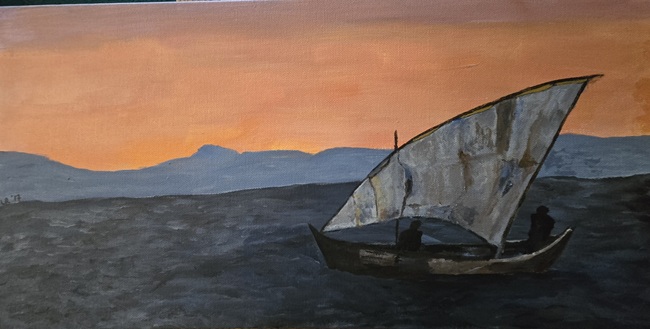Pablo Picasso said, “Art washes away from the soul the dust of everyday life.” The fact is art in our homes also collects the dust of everyday life. While we can do our best to keep that everyday dust away from our art items, what will happen to our art once we have gone? What steps can we take now to ensure our art is preserved now and in the future?

Now if you have a valuable art collection, you probably already know how to store, document, insure, and display your collection. But if what you own is more of sentimental value, with works done by friends and family (like what hangs on my walls), here are some tips to help ensure your art outlives you in safety.
First, look around and see what is hanging up on your walls. Sure, you know who is in the paintings, or what river is in the landscape, but when you are not around to give the details, will your next-of-kin know? I urge you to write on the back of the mat (or get a piece of paper and adhere it firmly to the back) with as many details as possible. My living room art includes four watercolor family portraits I commissioned from my friend Ruth Palmer Pitman, all from family photos. Sure, my children will recognize themselves in the paintings, but will they remember how old they were at the time? Will their children recognize their father as a child? My friend Ruth no longer lives in the area, and they will not recognize her signature, so I will include her name on the info on the back. Including the history of a piece of art is called its “provenance.” Err on the side of too much information; future generations will thank you.
If you are uncomfortable writing on the back of your art, keep a notebook or database with all the details, along with photos of each piece, with the important family papers. Chris Chapin-Tilton was left with 70 of her husband’s watercolors when artist Jac Tilton passed away recently, but she says, “I was with him when we traveled to so many of these places, so I know where they are.” Her best advice to others is to “document, document, document.” Jac left a detailed database listing location, size, cost, etc., and all she has to do is refer to that when displaying or selling any of his works.
Be like Jac and document.
Do not be like Mary Lee. This summer, my sister Mary Lee – travel agent by vocation, artist by avocation – passed away suddenly, leaving me with several dozen of her creations, along with all her earthly possessions. She did not document anything. She painted from the photos she took on her world travels, but I cannot tell one castle from another, and there are a lot of castles! In going through her photo albums of her trips I have recognized some of the locations of her art, but it would have been much easier had she written place and date on the back.
Many of us have more art than wall space and it is important to store the extras properly. Dan Soat of A Frame of Mind Custom Framing in Dubuque recommends storing artwork horizontally, using acid-free paper or foam board between the paintings, especially if the art is not framed. Soat says, “Keep the art flat, not rolled up. If a painting has been rolled up for a long period of time, it is very difficult to unroll it for framing without causing a crease somewhere.” Several of my sister’s acrylic canvases are a bit warped and it will be “fun” trying to get them into a frame.
Acid-free foam board (available at craft and hobby stores) should also be used as backing rather than cardboard when you are framing artwork. Over time, the acid in cardboard can cause discoloration, so it is also better to put acid-free paper or foam board between pieces when storing art. Cardboard is also susceptible to moisture and you certainly do not want mold growing on your artwork. If you need to mail any artwork, cardboard and butcher paper can be used temporarily for transportation but not long-term storage.
The ideal temperature at which to store art is 70-72 degrees, with humidity no more than 50%. That probably eliminates your garage as a good storage place or those extra shelves in the basement bathroom. (Does anyone really have extra shelves???) Your storage place should also be a place where the art will not be in direct sunlight. While natural lighting is usually the best for viewing art, exposure to sunlight over time may cause the paintings to fade, especially watercolors.
Final word: if you want to leave a piece of art to a certain relative or friend, include that in your documentation or the note on the back so everyone knows your intentions. Art should bring joy and fond memories for generations to come.
Tracey Rush is a local music teacher who has inherited her sister’s art supplies, so she will be spending her spare time dabbling in acrylics and watercolors, because it makes her happy.
This article was originally published in CHOICES For Fifty Plus, a Dubuque area magazine for people that are 50 and older. Single copies are available at Dubuque area newsstands or click here to read the digital version of the latest issue.
Read Julien’s Journal, CHOICES For Fifty Plus and Tri-State Home TRENDS from the Comfort of Your Home!
Click Here or call 563.557.7571 for convenient delivery to your home or business by mail of all three magazines for one low subscription price.


Comment here